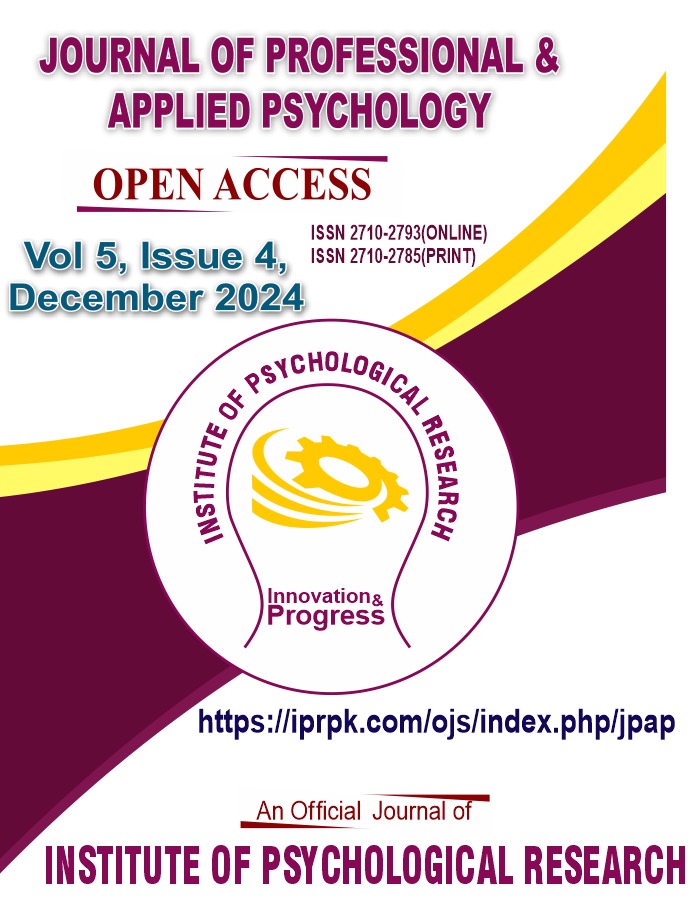Relationship between Dark Triad and Engagement in Social Networking Sites among University Students
DOI:
https://doi.org/10.52053/jpap.v5i4.344Keywords:
Dark Triad, Machiavellianism, Narcissism, Personality, Psychopathy, Social Networking Sites, University StudentsAbstract
This research examined the Dark Triad Personality factors, namely Machiavellianism, narcissism, and psychopathy in the online realm specifically focusing on university students’ participation in Facebook and Instagram. The sample consisted of three hundred and fifty undergraduate students, with ethical considerations ensuring the confidentiality and anonymity of participants and emphasizing the voluntary nature of participation. In this study, the methods employed are correlational and cross-sectional, to understand the association between the dark triad and the use of social networking sites among students aged between 18 and 25 years old. Study subjects were purposively selected using the purposive sampling technique. Participants filled out surveys that included Machiavellianism, Narcissism, and Psychopathy related items and Facebook and Instagram usage involvement. The present study reported that Dark Triad traits (Machiavellianism, Narcissism and Psychopathy) have a considerable contribution in social networking site (SNS) activities and adverse online activities. Demographic factors were also analyzed as important variables in usage of Facebook and Instagram, as well as the level of Psychopathy among users. The evidence shows that the intensity of the three traits, dark triads of personality, is directly related to the degree of engaging in manipulative and self-promoting activities online. The study also analyzed the discrepancies in SNS engagement and Dark Triad traits in relation to gender.
References
American Psychological Association. (2017). Ethical principles of psychologists and code of conduct. https://www.apa.org/ethics/code
Andreassen, C. S., Pallesen, S., & Griffiths, M. D. (2017). The relationship between addictive use of social media, narcissism, and self-esteem: Findings from a large national survey. Addictive Behaviors, 64, 287–293. https://doi.org/10.1016/j.addbeh.206.03.006
Barberis, N., Sanchez-Ruiz, M.-J., Cannavò, M., Calaresi, D., & Verrastro, V. (2023). The Dark Triad and Trait Emotional Intelligence as Predictors of Problematic Social Media use and Engagement: The Mediating Role of the Fear of Missing Out. Clinical Neuropsychiatry, 20(2), 129–140. https://doi.org/10.36131/cnfioritieditore20230205
Beer, D. (2008). Social network(ing) sites, Revisiting the story so far: A response to Danah Boyd & Nicole Ellison. Journal of Computer Mediated Communication, 13(2), 516–529. https://doi.org/10.1111/j.1083-6101.2008.00408.x
Boyd, D. M., & Ellison, N. B. (2007). Social network sites: Definition, history, and scholarship. Journal of Computer-Mediated Communication, 13(1), 210 230. https://doi.org/10.1111/j.1083-6101.007.00393.x
Brant, A. (2024). The impact of prolonged SNS exposure on self-perception. Journal of Social Media Studies,15(2), 123–135. https://doi.org/10.1234/jsms.2024.01502
Cao, X., Vogel, D. R., Guo, X., Liu, H., & Gu, J. (2013). A Maslow's hierarchy of needs analysis of social networking services continuance.
Journal of Service Management, 24(2), 170190. https://doi.org/10.1108/09564231311323939
Dixon, S. J. (2024, July 10). Most used social networks 2024, by number of users. Statista. https://www.statista.com
Ellison, N. B., Heino, R., & Gibbs, J. (2006). Managing impressions online: Self-presentation processes in the online dating environment. Journal of Computer-Mediated Communication, 11(2), 415–441. https://doi.org/10.1111/j.1083-6101.2006.00020.x
Festinger, L. (1954). A theory of social comparison processes. Human Relations, 7(2), 117–140. https://doi.org/10.1177/001872675400700202
Fox, J., & Moreland, J. J. (2015). The dark side of social networking sites: An exploration of the relational and psychological stressors associated with Facebook use and affordances. Computers in Human Behavior, 45, 168–176. https://doi.org/10.1016/j.chb.201411.083
Gerbner, G., Gross, L., Morgan, M., Signorielli, N., & Shanahan, J. (2002). Growing up with television: Cultivation processes. In J. Bryant &
D. Zillmann (Eds.), Media effects: Advances in theory and research (2nd ed., pp. 43–67). Lawrence Erlbaum Associates Publishers.Goffman, E. (1956). The Presentation of Self in Everyday Life. University of Edinburgh Social Sciences Research Centre.
Hu, X., & Lan, Y. (2023). The phenomenon of contemporary youth's "Bai Lan". Journal of Social Science, Humanities and Literature, 3(2),
–58. https://doi.org/10.26412/jsshl.v3i2.316
Hussain, Z., Wegmann, E., & Grifths, M. D. (2021). The association between problematic social networking site use, dark triad traits, and emotion dysregulation. BMC Psychology, 9.https://doi.org/10.1186/s40359-021- 00668-6
Jab?o?ska, M. R., & Zajdel, R. (2020). The Dark Triad Traits and Problematic Internet Use: Their Structure and Relations. Polish Sociological Review, 4, 477-496. https://www.ceeol.com/search/article-detail?id=919093
Jones, D. N., & Paulhus, D. L. (2014). Introducing the Short Dark Triad (SD3): A brief measure of dark personality traits. Assessment, 21(2),157–177. https://doi.org/10.1177/1073191113514105
Judson, M. S., Brown, D. E., & McKenna, K. Y. A. (2017). Social media, self-esteem, and impression management: The effects of social
networking sites on the self-esteem of young adults. Cyberpsychology, Behavior, and Social Networking, 20(5), 311–317.
https://doi.org/10.1089/cyber.2017.0319
K?r?k, A. M., Arslan, A., Çetinkaya, A., & Gül, M. (2015). A quantitative research on the level of social media addiction among young people in Turkey. International Journal of Sport Culture and Science, 3(3),
–122. https://doi.org/10.14486/IntJSC444_
Koc, Z., & Demir, M. (2024). Dark triad and social media addiction: A meta-analysis. Klinik Psikoloji Dergisi, 37(3), 536–550.
https://doi.org/10.1016/j.ijresmar.2020.05.001
Lee, S. Y. (2019). The influence of social media use on self-esteem and life satisfaction among adolescents: A longitudinal study. Journal of Youth and Adolescence, 48(2), 319–331.https://doi.org/10.1007/s10964-018-0922-x
Lopes, B., & Yu, H. (2017). Who do you troll and Why: An investigation into the Relationship between the Dark Triad Personalities and online trolling behaviors towards popular and less popular Facebook profiles. Computers in Human Behavior, 77, 69–76.
https://doi.org/10.1016/j.chb.2017.08.036
Nikbin, D., Aramo, T., Iranmanesh, M., & Ghobakhloo, M. (2022). Impact of brands' Facebook page characteristics and followers' comments on trust building and purchase intention: Alternative attractiveness as moderator. Journal of Consumer Behavior, 21(1),
–15. https://doi.org/10.1002/cb.2018
Nitschinsk, L., Tobin, S. J., & Vanman, E. J. (2022). The dark triad and online self-presentation styles and beliefs. Personality and Individual
Differences, 194, 111641. https://doi.org/10.1016/j.paid.2022.111641
Paulhus, D. L., & Williams, K. M. (2002). The Dark Triad of personality: Narcissism, Machiavellianism and psychopathy. Journal of Research in Personality, 36(6), 556-563. https://doi.org/10.1016/S0092-6566(02)00505-6
Petit, J., & Carcioppolo, N. (2020). Associations between the Dark Triad and online communication behavior: A brief report of preliminary findings. Communication Research Reports, 37(5), 235–244. https://doi.org/10.1080/08824096 2020.1862784
Przybylski, A. K., Murayama, K., DeHaan, C. R., & Gladwell, V. (2013). Motivational, emotional, and behavioral correlates of fear of missing out. Computers in Human Behavior, 29(4), 1841–1848. https://doi.org/10.1016/j.chb.2013.02.014
Rauthmann, J. F. (2012). The Dark Triad and interpersonal perception: Similarities and differences in the social consequences of narcissism, Machiavellianism, and psychopathy. Social Psychological and Personality Science, 3(4), 487 496. https://doi.org/10.1177/1948550611427608
Reer, F., Tang, W. Y., & Quandt, T. (2019). Psychosocial well-being and social media engagement: The mediating roles of social comparison orientation and fear of missing out. New Media & Society, 21(7), 1-24. https://doi.org/10.1177/1461444818823719
Servidio, R., Soraci, P., Griffiths, M. D., Boca, S., & Demetrovics, Z. (2024). Fear of missing out and problematic
social media use: A serial mediation model of social comparison and self esteem. Addictive Behaviors Reports,
, 100536. https://doi.org/10.1016/j.abrep.2024.100536
Sindermann, C., Sariyska, R., Lachmann, B., Brand, M., & Montag, C. (2018). Associations between the dark triad of personality and unspecified/specific forms of Internet-use disorder. Journal of Behavioral Addictions, 7(4), 985-992.
Sparavec, A., March, E., & Grieve, R. (2022). The Dark Triad, Empathy, and Motives to Use Social Media. Personality and Individual Differences, 194, 111647.https://doi.org/10.1016/j.paid.2022.111647
Sumner, C., Byers, A., Boochever, R., & Park, G. (2012). Predicting Dark Triad personality traits from Twitter usage and a linguistic analysis of tweets. In Proceedings - 2012 11th International Conference on Machine Learning and Applications (ICMLA 2012) (Vol. 2, pp. 370–374). IEEE. https://doi.org/10.1109/ICMLA.2012.218
Tiggemann, M., & Slater, A. (2014). NetGirls: The Internet, Facebook, and body image concern inadolescent girls. International Journal of Eating Disorders, 47(6), 630–643. https://doi.org/10.1002/eat.22314
Williams, K. M., Cooper, A., Howell, J. L., Yuille, J. C., & Paulhus, D. L. (2009). Associations between the dark triad of personality and unspecified forms of internet-use disorder. Psychiatry Research, 169(1), 1–8. https://doi.org/10.1016/j.psychres.208.06.008
Wirtz, J., Zeithaml, V. A., & Gistri, G. (2020). The role of social media content format and platform in users' engagement behavior. International Journal of Research in Marketing, 37(3),536–550. https://doi.org/10.1016/j.ijresmar.2020.05.001
Zhang, Y., & Zhao, X. (2020). Dark triad and cyber aggression among Chinese adolescents during COVID-19: A moderated mediation model. Frontiers in Psychology, 13, 1011123. https://doi.org/10.3389/fpsyg.2022.1011123
Downloads
Published
How to Cite
Issue
Section
Categories
License
Copyright (c) 2024 Fatima Muhammad, Uzma Ashiq

This work is licensed under a Creative Commons Attribution-NonCommercial 4.0 International License.
Creative Commons Attribution-Non Commercial 4.0 International (CC BY-NC 4.0) License: This article is distributed under the terms of the Creative Commons Attribution-Non Commercial 4.0 International License (https://www.creativecommons.org/licenses/by-nc/4.0/) which permits non-Commercial use, reproduction and distribution of the work without further permission provided the original work is attributed as specified on the Journal website at (https://iprpk.com/ojs/index.php/jpap)












